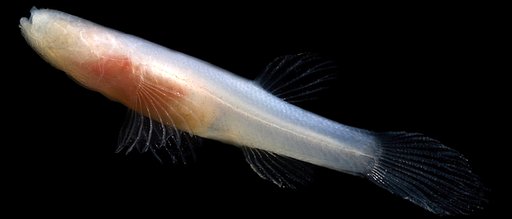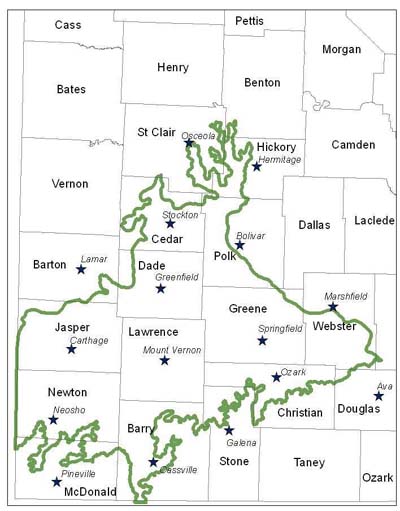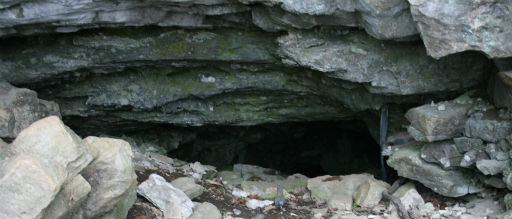
Habitat and Geography
The Ozark cavefish (Amblyopsis rosae) can be found in a geographically unique portion of the American southwest in a topographical region known as the Springfield Plateau. The Springfield Plateau stretches from the northern reaches of Arkansas to central Missouri, as well as a small section of neighboring Oklahoma (Brown & Johnson, 2001).
 Left: An image of the Springfield Plateau spanning Arkansas,
Missouri, and Oklahoma. Image courtesy of the United States Fish and
Wildelife Service.
Left: An image of the Springfield Plateau spanning Arkansas,
Missouri, and Oklahoma. Image courtesy of the United States Fish and
Wildelife Service.
Geologically, the Springfield Plateau region has several distinguishing features that make it unique from the surrounding landscape, but most notably, the telltale presence of uniquely formed sinkholes and caves. These caverns and sinkholes are dispersed throughout the region and are composed primarily of limestone and sandstone that, over time, allowed for their distinctive formations (Ozark Plateau Surfaces, 2012). It is in this environment that the cavefish is exclusively found, but what is it that makes this specific environment so ideal for this unique organism? To begin with, the distinctive natural subterranean features of this small stretch of land have remarkable underground caves and aquifers that the cavefish are able to thrive in. Also, this subterranean environment has allowed for the cavefish to remain relatively protected from the modern advances of farming and the migration of humans to the region (Brown & Johnson, 2001). In particular, the relative difficulties in accessing these underground aquifers have played a critical role as a deterrent to the drilling of wells for both agricultural use and drinking water (Brown & Johnson, 2001).
The majority of the population of Ozark cavefish can be found in a very high concentration in two specific caves in the Springfield Plateau in Logan Cave and Cave Springs Cave (Noltie & Wicks, 2001). Both of these caves are located in northwestern Arkansas and over 90% of the known cavefish population can be found in these two caves alone (Brown & Johnson, 2001). Thanks in large part to the connectivity of the underground caves that are found in this region, the cavefish population has the ability to travel to different subterranean waterways at will. They use the underground aquifers as a “cavefish highway” and rarely stay in one particular location of the cave for their entire lifespan. The majority of A. rosae travel to the Logan or Cave Springs caverns in order to find a mate, and due to the vast size of these two caves, a more substantial source of food (Brown & Johnson, 2001).
 Above: Turnback Creek Cave Spring, a protected cave in
Missouri where the Ozark cavefish is found in low
concentration. Image courtesy of the United States Fish and
Wildelife Service.
Above: Turnback Creek Cave Spring, a protected cave in
Missouri where the Ozark cavefish is found in low
concentration. Image courtesy of the United States Fish and
Wildelife Service.
When taking into account the environment that the cavefish live in, this organism has developed some remarkable adaptations to increase the likelihood of survival. The Ozark cavefish has lost all pigmentation of the skin, therefore, in an underground environment that is completely devoid of light, they are quite difficult to detect. Finally, they have also been noted by researchers to wedge their bodies into the many fissures found in the cavern. The cavefish have been known to stay in this hidden position for several days at a time while remaining practically immobile (Brown & Johnson, 2001).